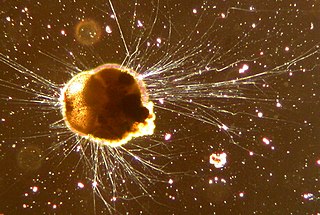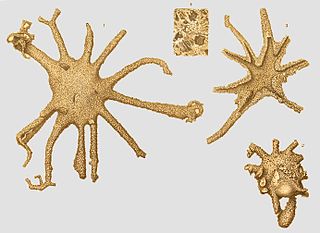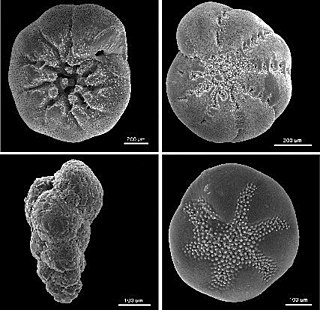
Foraminifera are single-celled organisms, members of a phylum or class of amoeboid protists characterized by streaming granular ectoplasm for catching food and other uses; and commonly an external shell of diverse forms and materials. Tests of chitin are believed to be the most primitive type. Most foraminifera are marine, the majority of which live on or within the seafloor sediment, while a smaller number float in the water column at various depths, which belong to the suborder Globigerinina. Fewer are known from freshwater or brackish conditions, and some very few (nonaquatic) soil species have been identified through molecular analysis of small subunit ribosomal DNA.
Ismailia is a genus of foraminifera with an agglutinated, planispirally coiled, semi-involute shell, known from the Egyptian Sinai, that lived during the early part of the Late Cretaceous (Cenomanian). Agglutinated shells are composed of selected foreign material cemented together.

The Fusulinida is an extinct order within the Foraminifera in which the tests are traditionally considered to have been composed of microgranular calcite. Like all forams, they were single-celled organisms. In advanced forms the test wall was differentiated into two or more layers. Loeblich and Tappan, 1988, gives a range from the Lower Silurian to the Upper Permian, with the fusulinid foraminifera going extinct with the Permian–Triassic extinction event. While the latter is true, a more supported projected timespan is from the Mid-Carboniferous period.

Alveolinidae is a family of spheroidal to fusiform milioline foraminifera with multiple apertures and complex interiors in which chambers are subdivided into chamberlets and subfloors interconnected by passageways. As with all Miliolina, the test wall in alveolinids is porcellaneous and imperforate. In living individuals the pseudopodia emerge through the multiple apertures that line the apertural or leading face of the test.

Miliolacea is one of five superfamilies belonging to the Miliolida,.
Discorbacea, Discorboidea in recent taxonomies, is a superfamily of foraminifera,, with a range extending from the Middle Triassic to the present, characterized by chambers arranged in a low trochspiral; an umbilical or interiomarginal aperture, with or without supplementary apertures; and a wall structure that is optically radial.
The Spirillinida are an order of foraminifera in which the test, or shell, primitively consists of an enrolled open tube, coming after the proloculus, wound planospirally or conically, commonly composed of an optically single crystal of calcite. The aperture is a simple opening at the end of the tube. Advanced forms with more than one chamber may consist of a few crystals, or rarely, a mosaic of crystals of calcite.
Miliamellus is a genus of Cenozoic benthic foraminifera with tests made of imperforate opaline silica. It is the only genus in the order Silicoloculinida and the family Silicoloculinidae. It is sometimes referred to by the junior synonym Silicoloculina.

Cibicides is a genus of cosmopolitan benthic foraminifera known from at least as far back as the Paleocene that extends down to the present.
Discorbis is a genus of benthic Foraminifera, that made its first appearance during the Eocene. Its present distribution is cosmopolitan.

Astrorhizata is a class within the foraminifera that comprises those species with primitive unilocular,, tests composed of aggulinated material or microgranular calcite. Forms may be subspherical, elongated, or irregular and may appear to become multichambered during growth.
Miliollata is a class wherein Foraminifera is regarded as a phylum that unites the porcelaneous Miliolida, and siliceous Rzehakinidae based on similarities of their tests. Previously the Rzehakinidae were included in the Textulariina based on test wall composition rather than test form. The meaning of Miliolida is retained.

Astrorhizana are a subclass of foraminifera characterized by simple tests composed of agglutinated material that can be irregular, spheroidal, or tubular and straight, branching or enrolled. Tests are non septate and consist of a single chamber following the proloculus. These are the Ammodiscacea of the Textulariina in the Treatise Part C, that range from the Cambrian to Recent.
Lagynana is a subclass of foraminifera which comprises Astrorhizata with membranous or pseudochitinous tests that may have ferruginous encrustations or more rarely small quantities of agglutinated material. The Lagynacea Schultze, 1854, of the Allogriomiina, is fairly equivalent.

Rotaliana is a subclass of benthic Foraminifera with multichambered tests of perforate hyaline calcite. Tests may be planospiral, low or high trochospiral, or serial. Interiors may be complex with secondary chambers and interconnecting canal systems. Rotaliana are separate from the planktonic Globigerinana although both have tests of similar composition. The Textulariana, which contains forms that are rather similar, differs in be agglutinated.
Miliamminana is a subclass of miliolates established by Mikhalevich, 1980 that combines two groups of foraminifers with agglutinated tests. They are the Rzehakinidae which previously were included in the Texulariina in the Treatise on Invertebrate Paleontology although milioline in form, and the milioline Schlumbergerinida which includes genera removed from the Miliolina. The rzehakinids are composed of finely agglutinated material, insoluble in acid, over an organic base. Schlumbergerinids are composed of acid soluble agglutinated material over a porcelenous base. The unifying character is the nature of their coiling in which there are two tubular chambers, or sections, per whorl arranged in various planes and the fact that they are in part all agglutinated.
Spirocyclina is a genus of large forams, with a flat test as much as 10mm in diameter. Coiling is planispiral to slightly asymmetric and mostly involute, some becoming uncoiled with a straight final stage. The final whorl, or stage, has about 25 strongly arcuate chambers. Composition is of agglutinated matter, the outer layer of the wall imperforate. Chambers are subdivided into secondary chamberlets by internal structures. The aperture consists of a double row of pores on the apertural face. Anchispirocyclina and Martiguesia are among related genera.
Haurania is a genus of elongated, finely agglutinated benthic foraminifera included in the Spirocyclinidae. The test is free, starting with a brief planispiral coil followed by a straight uncoiled stage. The exterior is imperforate, the interior divided by radial septula or beams, perpendicular to the septa and outer wall. The aperture is cribrate, a series of openings on the terminal face.
Martiguesia is a genus of agglutinated benthic forams from the Upper Cretaceous (Santonian) of France. The test is free, the early stage planispirally coiled, becoming nearly straight during later growth. The agglutinated wall is externally imperforate, the interior with a coarse alveolar network. Chambers are subdivided and almost completely filled by irregular radial pillars. The aperture, cribrate.

Foraminiferal tests are the tests of Foraminifera.








